Natural Field Airborne Electromagnetics—History of Development and Current Exploration Capabilities
Abstract
:1. Introduction
- the depth of investigation does not always meet exploration requirements, especially in conductive environments;
- the measured signal and depth of investigation are highly dependent on the transmitter height, tilt, and geometry. The dependance creates difficulties and restrictions for surveys in rugged terrain;
- there are challenges in getting a measurable response in resistive terrain and with subtle resistivity contrasts; and there are parasitic IP and SPM effects on measured induction under specific near surface conditions [5].
2. Review of the Development of the Airborne Natural Electromagnetic Fields Method and the MobileMT Technology
- -
- the MT sounding characteristics are the impedance tensor described by the relationships between magnetic and electric field components, and apparent resistivities, derived from the impedance tensor, corresponding to different frequencies;
- -
- whereas the MV sounding characteristic is the ‘tipper’, which describes the relationship between the vertical and horizontal components of the magnetic field.
2.1. Original AFMAG Method
2.2. Experimental Versions of AFMAG
2.3. Tipper AFMAG-ZTEM
2.4. MobileMT Technology
3. MobileMT Data Inversions
3.1. Conjugate Gradient Adaptive Unconstrained 1D Inversion
3.2. Detail and Goal-Oriented 2D Data Inversion
- It is the first goal-oriented adaptive finite element code for MT;
- Uses structured and unstructured model grids (mesh);
- 2.5D EM problem statement (i.e., 3D EM source field in a 2D conductive environment);
- Parallel calculations implementation.
3.3. 3D Data Inversion
4. Natural AEM Field Examples: Capabilities and Advantages of MobileMT
- Measurement of magnetic field variations with three orthogonal coils (total field). This provides sensitivity to any direction of geoelectrical boundary, from horizontal to vertical;
- Measurements are obtained over 3 decades of frequency, from 19 Hz to 26 kHz. This allows imaging near surface structures as well as those at > 1 km depth, depending on the conductance of the geologic environment;
- The frequency range is divided into 30 windows that provide high in-depth resolution and a good opportunity for data selection, depending on cultural noise sources, natural EM field signal, and exploration goals;
- The high sampling rate of the airborne data as well as the base station data result in bias free and denoised data.
- The main advantages of the natural field method, in general, include:
- The depth of investigation always exceeds the capabilities of systems with controlled sources;
- The method is sensitive not only to conductors, but to resistivity differences in the range of thousands and tens of thousands of ohm-m; which is specifically a challenge for existing time domain systems. At the other end, for time-domain systems, response from superconductors (hundreds and thousands of Siemens) is not visible in the off-time channels of the dB/dt stream. For the natural field EM principle, it is not a limitation;
- There is no critical dependence on the terrain clearance of the system. This allows for less aggressive flying in rugged terrain conditions, improving the overall safety of data acquisition;
- Inherent to impulse time-domain systems are IP and SPM parasitic effects that badly influence the inductive response. These effects are not formed, and do not distort the secondary electromagnetic field data for methods using natural fields.
4.1. Aylmer IOCG Mineralization Exploration
4.2. Kainantu Exploration
4.3. Kimberlite Pipe
4.4. Olympic Dam Copper Province
5. Discussion
Author Contributions
Funding
Data Availability Statement
Acknowledgments
Conflicts of Interest
References
- Nabighian, M.N. Application, Parts A and B. In Electromagnetic Methods in Applied Geophysics; Investigations in Geophysics; Society of Exploration Geophysicists: Tulsa, OK, USA, 1991; Volume 2, ISBN 978-1-56080-022-4. [Google Scholar]
- Eaton, P.A.; Anderson, R.G.; Queen, S.V.; Nilsson, B.Y.; Lauritsen, E.; Barnett, C.T.; Olm, M.; Mitchell, S. Helicopter Time-Domain Electromagnetics—Newmont and the NEWTEM Experience. Geophysics 2013, 78, W45–W56. [Google Scholar] [CrossRef]
- Fountain, D. 60 Years of Airborne EM—Focus on the Last Decade. In Proceedings of the AEM2008—International Conference on Airborne Electromagnetics, Haikko Manor, Finland, 28–30 May 2008; pp. 1–5. [Google Scholar]
- Allard, M.; Milkereit, B. On the Origin of the HTEM Species. In Proceedings of the Exploration 07: Fifth Decennial International Conference on Mineral Exploration, Toronto, ON, Canada, 9–12 September 2007; pp. 355–374. [Google Scholar]
- Macnae, J. Advances in Electromagnetic Data Processing: Noise, Signal, SPM and AIP. In Proceedings of the Exploration 17: Sixth Decennial International Conference on Mineral Exploration, Toronto, ON, Canada, 21–25 October 2017; pp. 191–208. [Google Scholar]
- Tikhonov, A.N. On Determining Electrical Characteristics of the Deep Layers of the Earth’s Crust. Dokl. Akad. Nauk. SSSR 1950, 73, 295–297. [Google Scholar]
- Cagniard, L. Basic Theory of the Magneto-Telluric Method of Geophysical Prospecting. Geophysics 1953, 18, 605–635. [Google Scholar] [CrossRef]
- Dmitriev, V.I.; Berdichevsky, M.N. The Fundamental Model of Magnetotelluric Sounding. Proc. IEEE 1979, 67, 1034–1044. [Google Scholar] [CrossRef]
- Berdichevsky, M.N.; Dmitriev, V.I.; Golubtsova, N.S.; Mershchikova, N.A.; Pushkarev, P.Y. Magnetovariational Sounding: New Possibilities. Izv. Phys. Solid Earth 2003, 39, 701–727. [Google Scholar]
- Berdichevsky, M.N.; Zhdanov, M.S.; Pyankova, T. Advanced Theory of Deep Geomagnetic Sounding. Methods Geochem. Geophys. 1984, 19, 480. [Google Scholar]
- Varentsov, I.M.; Kulikov, V.A.; Yakovlev, A.G.; Yakovlev, D.V. Possibilities of Magnetotelluric Methods in Geophysical Exploration for Ore Minerals. Izv. Phys. Solid Earth 2013, 49, 309–328. [Google Scholar] [CrossRef]
- Ward, S.H.; Cartier, W.O.; Harvey, M.A.; McLaughlin, G.H.; Robinson, W.A. Prospecting by Use of Natural Alternating Magnetic Fields of Audio and Sub-Audio Frequencies. Trans. Can. Inst. Min. Met. 1958, 61, 261. [Google Scholar]
- Ward, S.H. AFMAG—Airborne and Ground. Geophysics 1959, 24, 761–787. [Google Scholar] [CrossRef]
- Ward, S.H.; O’Donnell, J.; Rivera, R.; Ware, G.H.; Fraser, D.C. AFMAG—Applications and Limitations. Geophysics 1966, 31, 576–605. [Google Scholar] [CrossRef]
- Ward, S.H.; O’Brien, D.P.; Parry, J.R.; McKnight, B.K. AFMAG—Interpretation. Geophysics 1968, 33, 621–644. [Google Scholar] [CrossRef]
- Thomson, S.; Fountain, D.; Watts, T. Airborne Geophysics–Evolution and Revolution. In Proceedings of the Exploration 07: Fifth Decennial International Conference on Mineral Exploration, Toronto, ON, Canada, 9–12 September 2007; Volume 7, pp. 19–37. [Google Scholar]
- Morrison, E.; (Geotech Ltd., Toronto, ON, Canada). Personal Communcation, 2005.
- Ward, S.H. Part C: The Electromagnetic Method. In Mining Geophysics Volume II, Theory; Society of Exploration Geophysics: Tulsa, OK, USA, 1967; pp. 224–372. [Google Scholar]
- Dentith, M.; Mudge, S.T. Geophysics for the Mineral Exploration Geoscientist; Cambridge University Press: Cambridge, UK, 2014. [Google Scholar] [CrossRef] [Green Version]
- Nabighian, M.N.; Asten, M.W. Metalliferous Mining Geophysics—State of the Art in the Last Decade of the 20th Century and the Beginning of the New Millennium. Geophysics 2002, 67, 964–978. [Google Scholar] [CrossRef]
- Christopherson, K.R. EM in the 21st Century–Looking for Oil, Gas and Water. In Proceedings of the 16th Workshop on Electromagnetic Induction in the Earth, Santa Fe, NM, USA, 16–22 June 2002; pp. 16–22. [Google Scholar]
- Lo, B.; Kuzmin, P.; Morrison, E. Field Tests of Geotech’s Airborne AFMAG EM System. In Proceedings of the Australian Earth Sciences Convention 2006—18th ASEG Conference, Melbourne, Australia, 2–7 July 2006; pp. 1–5. [Google Scholar]
- Kaminski, V.F.; Kuzmin, P.; Legault, J.M. AirMt–Passive Airborne EM System. In Proceedings of the 3rd CMOS-CGU Congress, Ottawa, ON, Canada, 31 May–4 June 2010. [Google Scholar]
- Legault, J.M. Ten Years of Passive Airborne AFMAG EM Development for Mineral Exploration. In Proceedings of the 82nd Society of Exploration Geophysicists International Exposition and Annual Meeting, Las Vegas, NV, USA, 4–9 November 2012. [Google Scholar]
- Labson, V.F.; Becker, A.; Morrison, H.F.; Conti, U. Geophysical Exploration with Audiofrequency Natural Magnetic Fields. Geophysics 1985, 50, 656–664. [Google Scholar] [CrossRef]
- Gribenko, A.V.; Zhdanov, M.S.; Cox, L.H.; Wilson, G.A.; Legault, J.; Zhao, S.; Fisk, K. 3D Inversion of AirMt AFMAG Data. In Proceedings of the 82nd Society of Exploration Geophysicists International Exposition and Annual Meeting, Las Vegas, NV, USA, 4–9 November 2012. [Google Scholar]
- Vozoff, K. The Magnetotelluric Method in the Exploration of Sedimentary Basins. Geophysics 1972, 37, 98–141. [Google Scholar] [CrossRef]
- Morrison, E.B.; Kuzmin, P.V. System, Method and Computer Product Geological Surveying Utilizing Natural Electromagnetic Fields. U.S. Patent No. 6,876,202, 5 April 2005. [Google Scholar]
- Legault, J.M.; Prikhodko, A.; Tishin, P.; Dodds, J. New Airborne EM Systems Development for 2013. In Proceedings of the CAMESE Innovations Forum, Toronto, ON, Canada, 3 March 2013. [Google Scholar]
- Lo, B.; Zang, M. Numerical Modeling of Z-TEM (Airborne AFMAG) Responses to Guide Exploration Strategies. In Proceedings of the 78th Society of Exploration Geophysicists International Exposition and Annual Meeting, Las Vegas, NV, USA, 9–14 November 2008; pp. 1098–1102. [Google Scholar]
- Jansen, J.C.; Cristall, J.A. Mineral Exploration Using Natural EM Fields. In Proceedings of the Exploration 17: Sixth Decennial International Conference on Mineral Exploration, Toronto, ON, Canada, 21–25 October 2017. [Google Scholar]
- Kuzmin, P.V.; Borel, G.; Morrison, E.; Dodds, J. Geophysical Prospecting Using Rotationally Invariant Parameters of Natural Electromagnetic Fields. U.S. Patent No. 8,289,023, 16 October 2012. [Google Scholar]
- Legault, J.M.; Kumar, H.; Milicevic, B.; Hulbert, L. ZTEM Airborne Tipper AFMAG Test Survey over a Magmatic Copper-Nickel Target at Axis Lake in Northern Saskatchewan. In Proceedings of the 79th Society of Exploration Geophysicists International Exposition and Annual Meeting, Houston, TX, USA, 25–30 October 2009; pp. 1272–1276. [Google Scholar]
- Lo, B.; Legault, J.; Kuzmin, P.; Combrinck, M. Z-TEM (Airborne AFMAG) Tests over Unconformity Uranium Deposits. In Proceedings of the Australian Earth Sciences Convention 2009—20th ASEG Conference, Adelaide, Australia, 22–26 February 2009; pp. 1–6. [Google Scholar]
- Sattel, D.; Witherly, K.; Kaminski, V. A Brief Analysis of MobileMT Data. In Proceedings of the 82nd Society of Exploration Geophysicists International Exposition and Annual Meeting, San Antonio, TX, USA, 15–20 September 2019; pp. 2138–2142. [Google Scholar]
- Bagrianski, A.; Kuzmin, P.; Prikhodko, A. AFMAG Evolution–Expanding Limits. In Proceedings of the SAGA 2019—16th Bienniel Conference and Exhibition, Durban, South Africa, 6–9 October 2019; pp. 1–4. [Google Scholar]
- Zhdanov, M.S. Geophysical Electromagnetic Theory and Methods; Elsevier: Amsterdam, The Netherlands, 2009. [Google Scholar]
- Zhdanov, M.S. Geophysical Inverse Theory and Regularization Problems; Elsevier: Amsterdam, The Netherlands, 2002; Volume 36. [Google Scholar]
- Golubev, N.G.; Varentsov, I.M. MT-Data Inversion: Stable Optimization Methods and Interactive Graphics. In Proceedings of the XII Workshop on EM-Induction in the Earth, Brest, France, 8–13 August 1994. [Google Scholar]
- Key, K.; Ovall, J. A Parallel Goal-Oriented Adaptive Finite Element Method for 2.5-D Electromagnetic Modelling. Geophys. J. Int. 2011, 186, 137–154. [Google Scholar] [CrossRef]
- Key, K. MARE2DEM: A 2-D Inversion Code for Controlled-Source Electromagnetic and Magnetotelluric Data. Geophys. J. Int. 2016, 207, 571–588. [Google Scholar] [CrossRef]
- Jahandari, H.; Farquharson, C.G. 3-D Minimum-Structure Inversion of Magnetotelluric Data Using the Finite-Element Method and Tetrahedral Grids. Geophys. J. Int. 2017, 211, 1189–1205. [Google Scholar] [CrossRef]
- Fiset, N. Report on a Helicopter-Borne Versatile Time Domain Electromagnetic (VTEM Plus) and Horizontal Magnetic Gradiometer Geophysical Survey; Geotech Ltd.: Aurora, ON, Canada, 2011. [Google Scholar]
- MobileMT Survey over the IOCG-AYLMER Property (a Greenfield Case Study)—Expert Geophysics Limited. Available online: https://www.expertgeophysics.com/wp-content/uploads/2020/12/MobileMT-survey-over-the-Aylmer-IOCG.pdf (accessed on 4 April 2022).
- Kainantu Mine. Available online: https://k92mining.com/kainantu-mine/ (accessed on 4 April 2022).
- Sobie, P. Report on 2003–2004 Exploration on the Klock Property Larder Lake Mining Division; Northeastern Ontario of Sudbury Contact Mines Limited: Toronto, ON, Canada, 2007. [Google Scholar]
- Sobie, P.; Lang, G. Technical Report on the Timiskaming Diamond Project; NE Ontario and NW Quebec of Contact Diamond Corp: Toronto, ON, Canada, 2006. [Google Scholar]
- McClenaghan, M.B.; Kjarsgaard, I.M.; Kjarsgaard, B.A. Indicator Mineralogy of the KL-01 and KL-22 Kimberlites, Lake Timiskaming Kimberlite Field, Ontario; Geological Survey of Canada Open File 5800; Natural Resources Canada: Ottawa, QC, Canada, 2008. [Google Scholar]
- Cowan, D.; Dentith, M. Unconformity-Related Copper Mineralisation on the Stuart Shelf, South Australia: Geophysical Responses of Mineralisation and the Mineralised Environment. In Proceedings of the Australian Earth Sciences Convention 2003—16th ASEG Conference, Adelaide, Australia, 16–19 February 2003; pp. 197–212. [Google Scholar]
- Elizabeth Creek—CODA Minerals. Available online: https://www.codaminerals.com/projects/ (accessed on 4 April 2022).
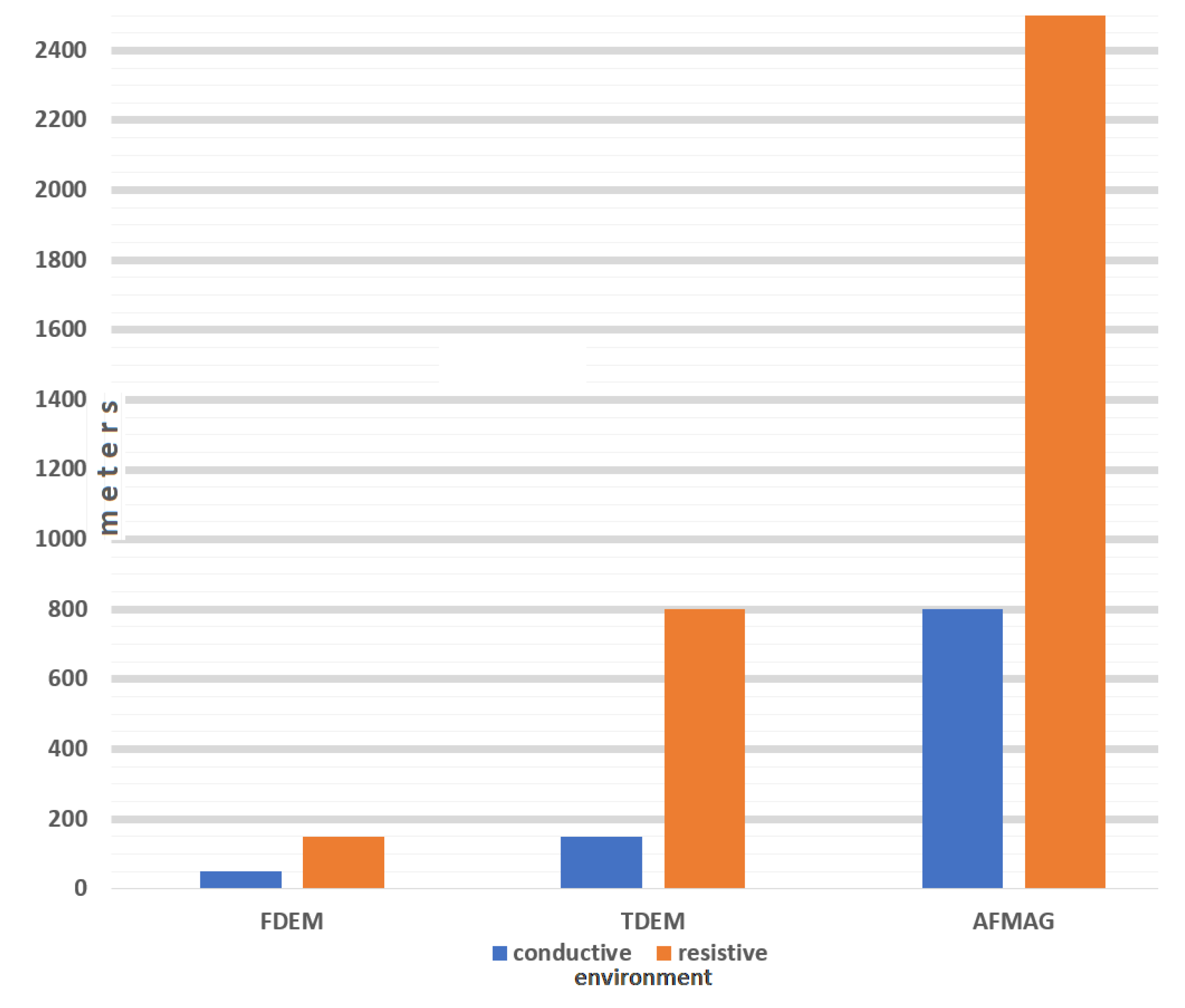
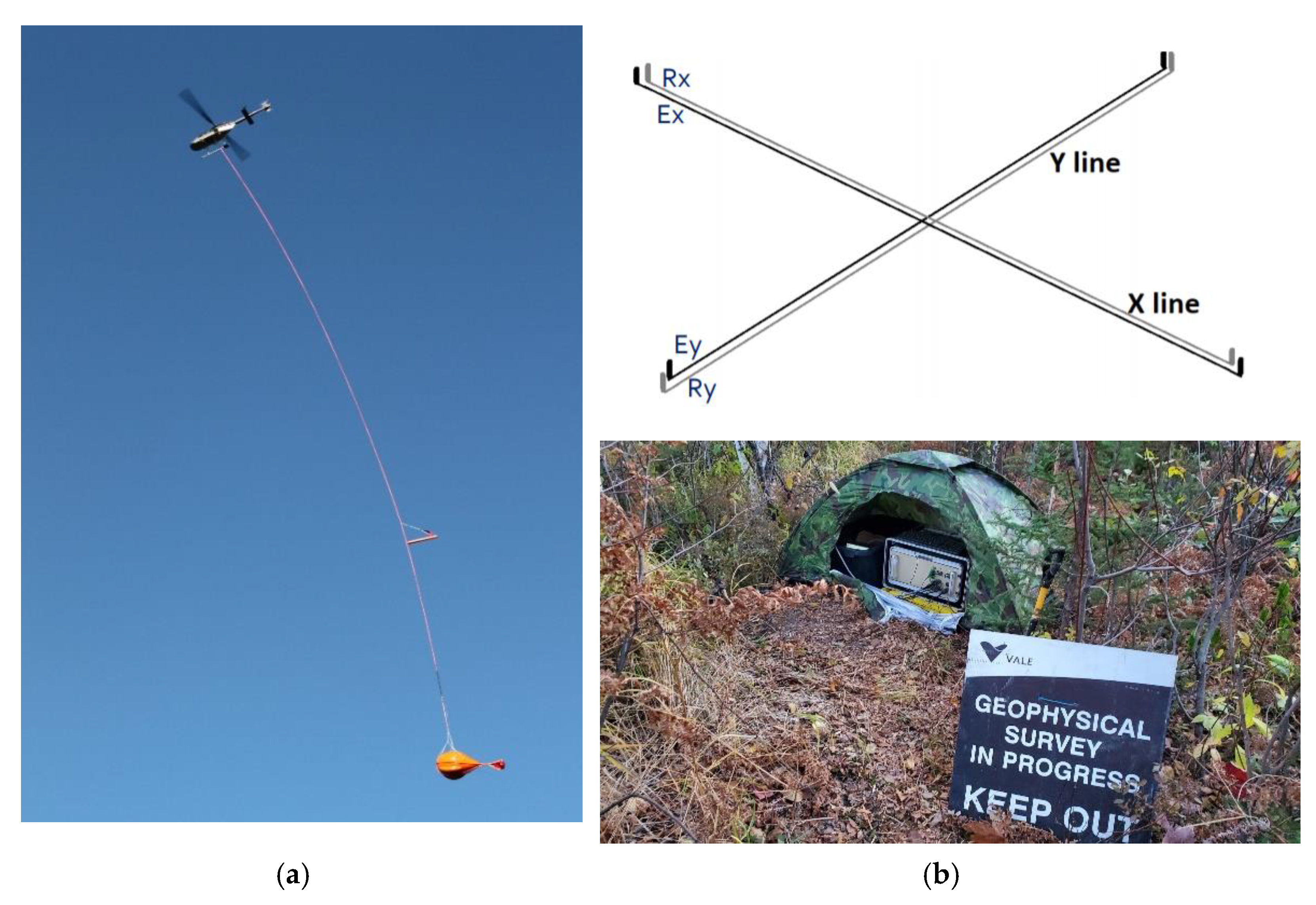


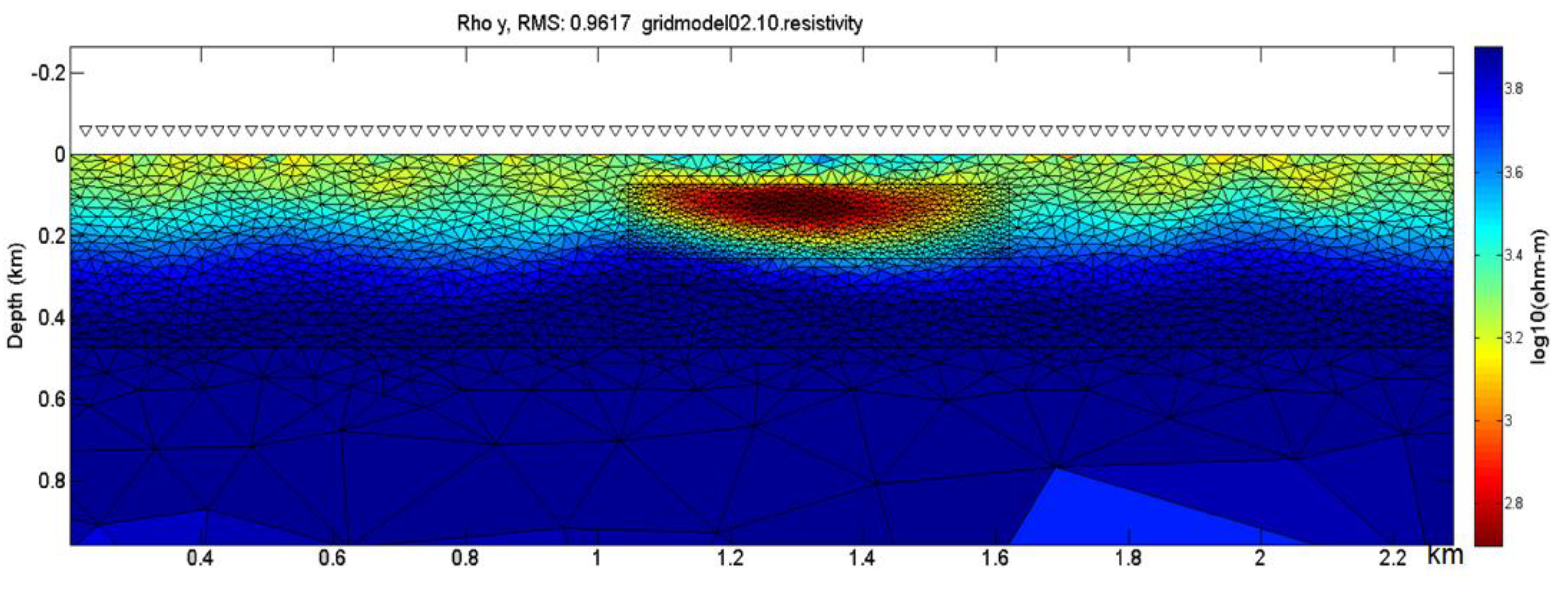
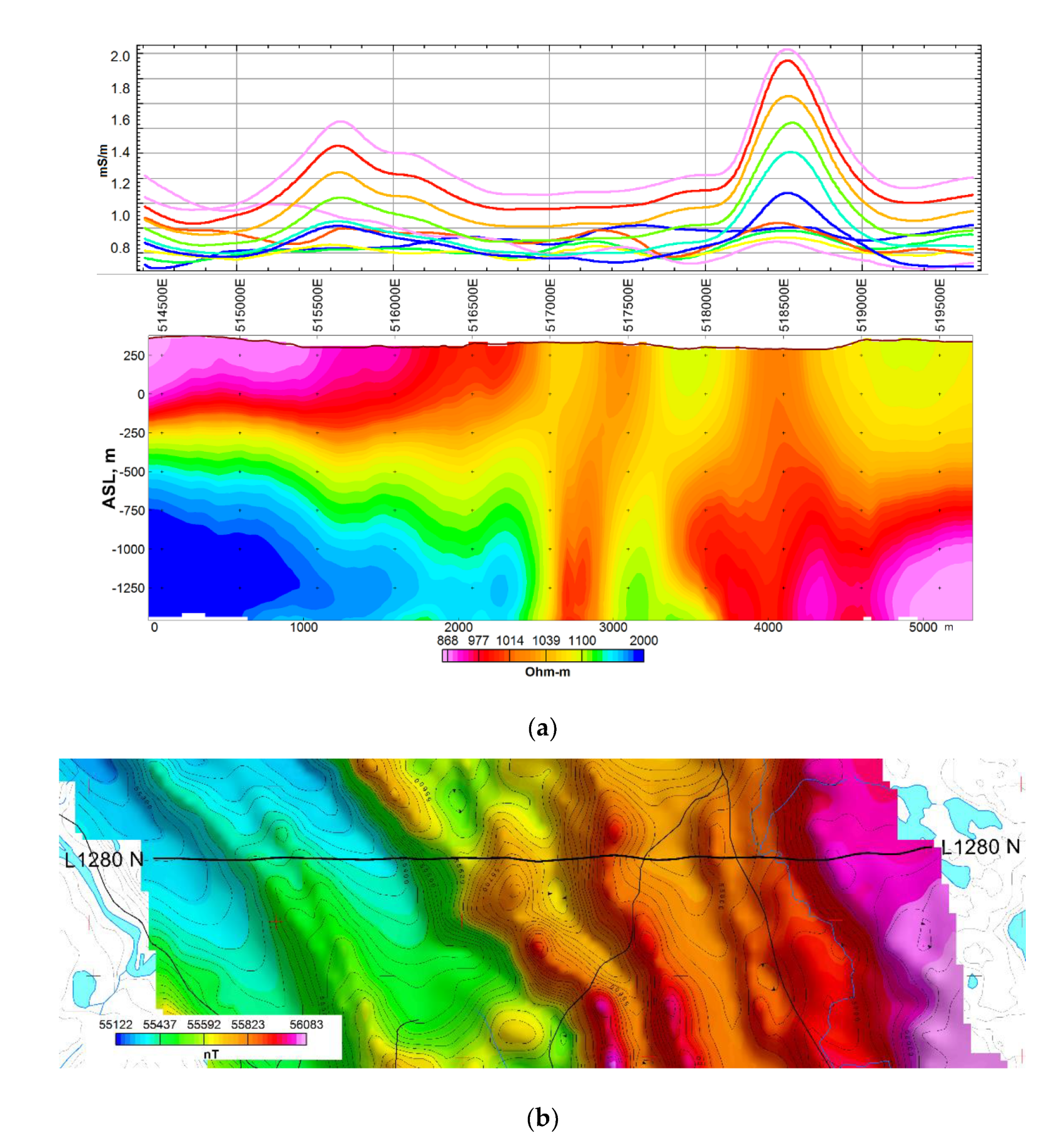
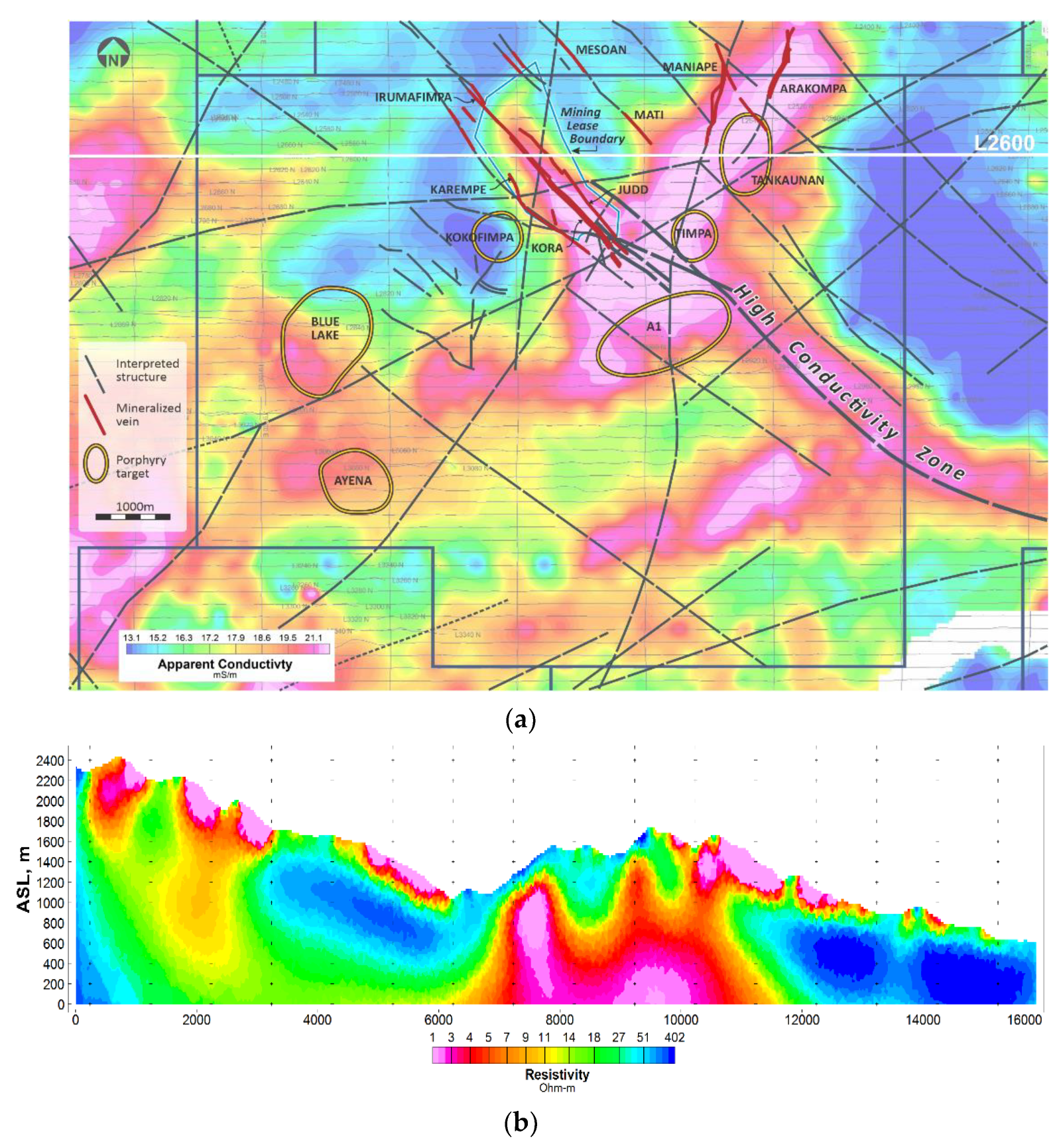
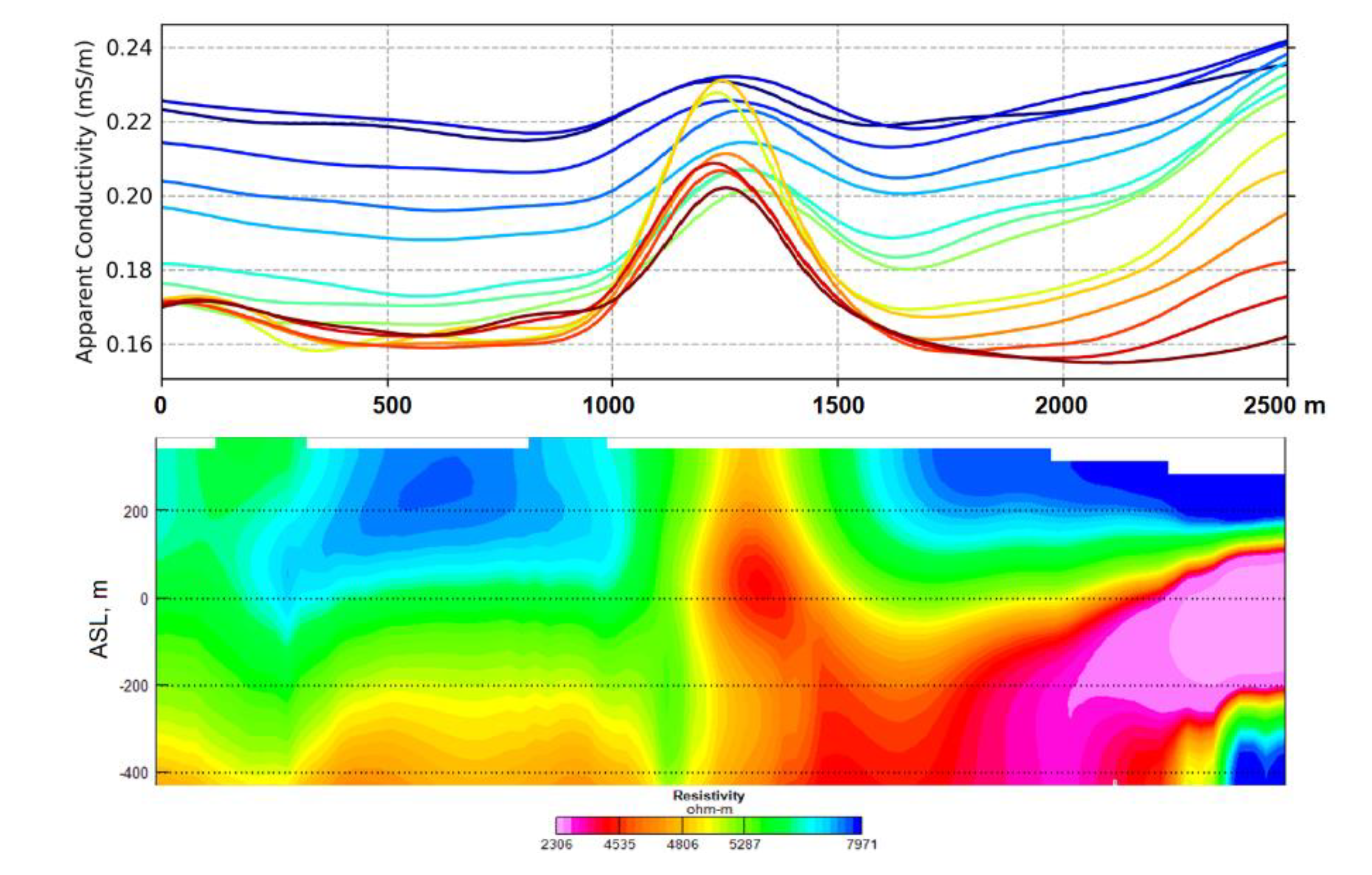
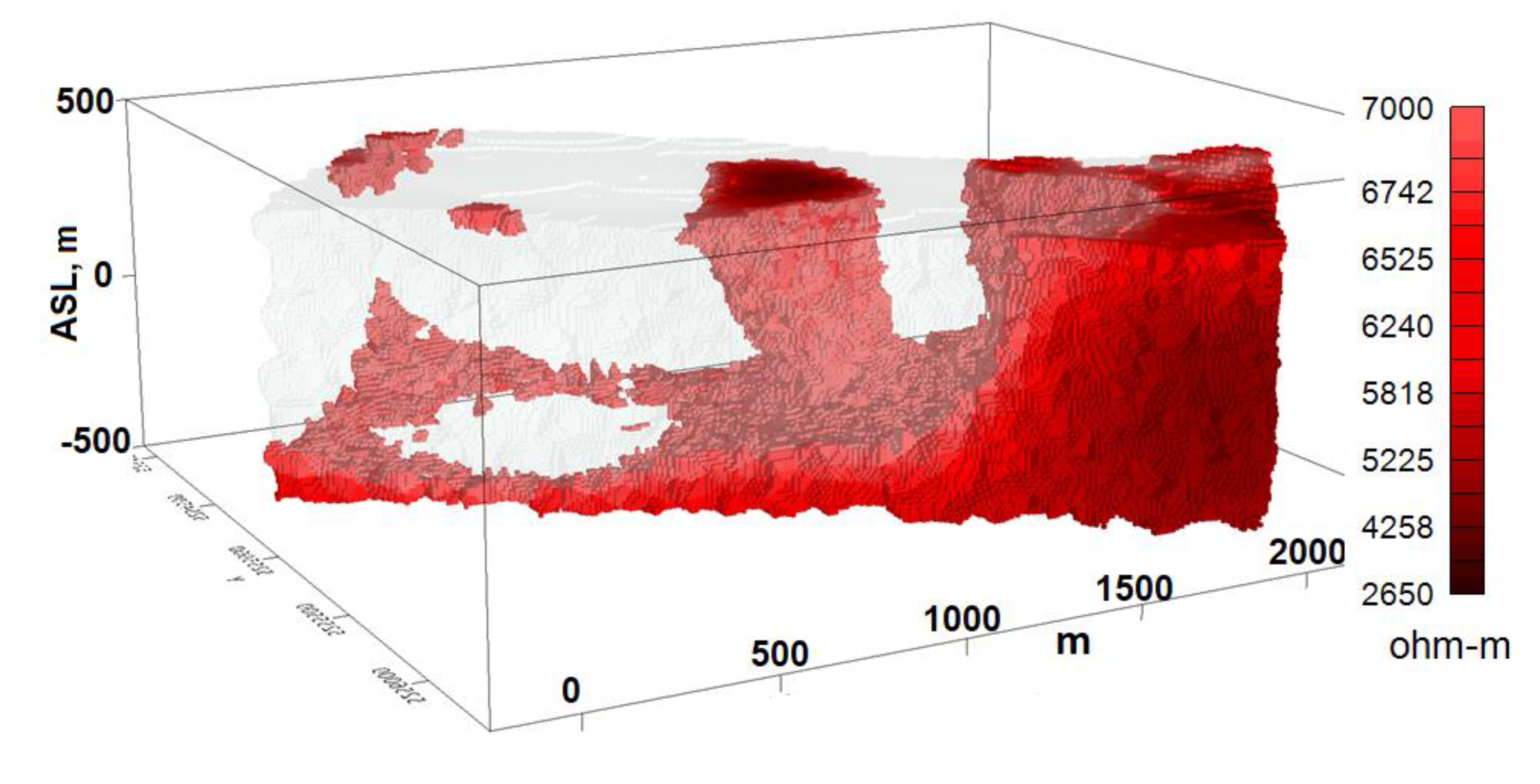
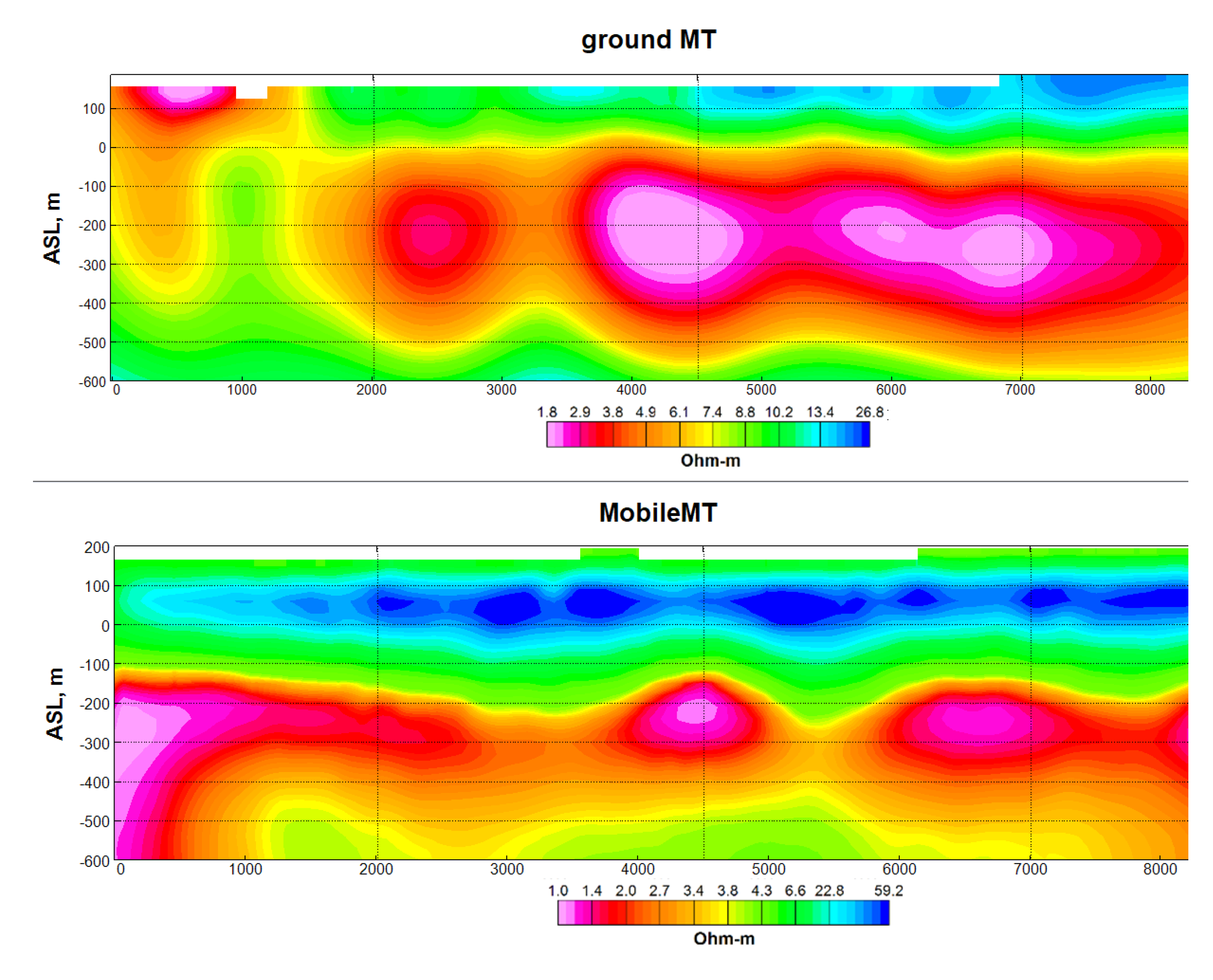
| Detector type | Two inductive coils in the air at 450 to the horizontal and to each other in the direction of flight. The components are compared electronically (H-field). |
| Output data | Tilt component of the magnetic field along the line direction. Deflections are proportional to the tilt of the plane of polarization. |
| Frequency bands (Hz) | Typical 150; 510. |
| Data Sampling Rate | No digital recording. |
| Bird tilting motion compensation | Yes. |
| Signal bias | Yes. |
| Sensitivity to subsurface geoelectrical differentiations | It is difficult or impossible to recover conductors with parallel axes to the direction of the inducing field. |
| Detector type | One vertical field inductive coil in the air (H-field); Two horizontal field inductive coils on the ground (H-field). |
| Output data | X and Y in-phase and quadrature tipper data. |
| Frequency bands | Typical 32, 45, 90, 180, 360, 720 Hz [33,34]. |
| Data Sampling Rate | 2000 Hz [30]. |
| Bird tilting motion compensation | Yes. |
| Signal bias | Yes. |
| Sensitivity to subsurface geoelectrical differentiations | Lack of ability to image layered geology; Sensitivity “to current density variations caused by conductivity contrasts, but not to the absolute conductivities themselves” [31]. |
| Detector type | Three orthogonal inductive coils in the air (H-field); two pairs perpendicular grounded electric lines (E-field). |
| Output data | Admittance data (apparent conductivity). |
| Frequency bands | Up to 30 frequency windows in the 19-26,000 Hz range. |
| Data Sampling Rate | 73,728 Hz. |
| Bird tilting motion compensation | Not required. |
| Signal bias | No. |
| Sensitivity to subsurface geoelectrical differentiations | Sensitive to the absolute conductivities and to geoelectrical boundaries of any direction. |
Publisher’s Note: MDPI stays neutral with regard to jurisdictional claims in published maps and institutional affiliations. |
© 2022 by the authors. Licensee MDPI, Basel, Switzerland. This article is an open access article distributed under the terms and conditions of the Creative Commons Attribution (CC BY) license (https://creativecommons.org/licenses/by/4.0/).
Share and Cite
Prikhodko, A.; Bagrianski, A.; Kuzmin, P.; Sirohey, A. Natural Field Airborne Electromagnetics—History of Development and Current Exploration Capabilities. Minerals 2022, 12, 583. https://doi.org/10.3390/min12050583
Prikhodko A, Bagrianski A, Kuzmin P, Sirohey A. Natural Field Airborne Electromagnetics—History of Development and Current Exploration Capabilities. Minerals. 2022; 12(5):583. https://doi.org/10.3390/min12050583
Chicago/Turabian StylePrikhodko, Alexander, Andrei Bagrianski, Petr Kuzmin, and Aamna Sirohey. 2022. "Natural Field Airborne Electromagnetics—History of Development and Current Exploration Capabilities" Minerals 12, no. 5: 583. https://doi.org/10.3390/min12050583
APA StylePrikhodko, A., Bagrianski, A., Kuzmin, P., & Sirohey, A. (2022). Natural Field Airborne Electromagnetics—History of Development and Current Exploration Capabilities. Minerals, 12(5), 583. https://doi.org/10.3390/min12050583






